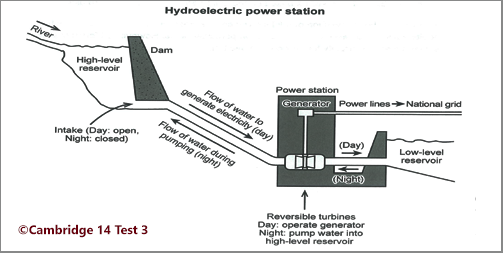hydroelectric power station
The process diagram illustrates steps of how a hydroelectric powerplant produce electricity.
The power station is situated in between two water reservoirs, high-level and low-level. There are two stages in electricity production. At day water flows down to the power station, generating power. At night water stored in the lower-level reservoir is pumped to the high-level one, refilling the water store.
In order to collect water coming from rivers in the high-level reservoir, a dam is constructed. During the day, the intake under the dam is open and water flows down through the reversible turbines, operating the generator to produce electricity. The power then transfers to national grid through power lines, while the flow of water is stored in the lower-level reservoir.
At night, water in low-level reservoir is pumped back into the high-level one using the same turbines in power station and pipe lines. In this stage, the intake is closed. When water is transferred into the high-level reservoir, the power station is ready to start the procedure of power generation again.

cam14test3task1.png
